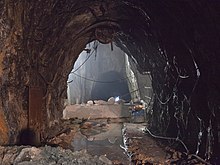Fantiscritti

With Fantiscritti a mountain in the will Apuan Alps and an important quarry area of marble above the small town Miseglia above Carrara designated. It is one of the three important Carrara marble quarries .
Name and meaning
The Fantiscritti mountain is 630 meters high. The name comes from a small Roman temple, an aedicule , from the 3rd century, which was found in a quarry . On the aedicule are Hercules with Jupiter and Bacchus . On this votive panel , below an architectural arch from left to right, is Hercules with a club and a lion's skin , Jupiter and Kionysus with the panther scepter. In 1442, Cyriacus of Ancona found this tablet in good condition. Visitors have been scratching their names on this tablet since the Renaissance; the first carving is from 1584 and the latest from 1840. In 1863 this artifact was transported to the Carrara Academy of Art.
The Fantiscritti quarries have been visited by important sculptors since the Renaissance . In the quarries of Fantiscritti carvings of names were Antonio Canova , the chief representative of the classical stone carving and Giambologna , a Flemish-Italian sculptor of the Florentine school of Mannerism and early Baroque , found.
Underground quarry
In the valley basin of Fantiscritti, in which there are about 30 quarries, the marble types Ordinario (whitish), Venato (white and gray), Cremo (light gray) and earlier the zebrino (gray-green striped) are quarried near Ponti di Vara. At Ponti di Vara there are two stone arch bridges over which the original marble path led. The five-arched bridge is now used as a road.
The Galleria Ravaccione underground quarry is located in the basin and can be visited. The quarry can be reached in a 1,200 meter long tunnel. The quality of this marble was discovered in the middle of the tunnel when a tunnel was cut through this mountain to connect the Fantiscritti and Torano valleys for marble transport. Today this tunnel is only used as a single lane to the underground quarry at 600 meters in the middle of the tunnel. Above this tunnel there is a high “marble mountain” and another open quarry. The tunnel can be driven on as part of a guided tour and the quarry can be viewed by tourists.
Marble Museum
In front of the Galleria Ravaccione underground quarry, there is a private, open-air marble museum and a square that hosts open-air concerts and theatrical performances. A marble museum run by Walter Danesi shows numerous exhibits made of Carrara marble, traditional tools and machines in the open air and a sparsely furnished wooden hut furnished in the same way as the stone carvers used to live in the mountains of Carrara. There is a souvenir shop in front of the museum and a bistro opposite where the stone workers and others have lunch. In the immediate vicinity of the museum there is a sculptor's workshop, in which two robots controlled by a PC mill sculptures out of marble, which are then finely worked over by stone sculptors .
literature
- Luciana and Tiziano Mannoni: Marble, Material and Culture , Callwey, Munich 1980, ISBN 3-7667-0505-9
Web links
- Walter Danesi's quarry museum - Fantiscritti Carrara
- Underground quarry
- The work of the robot that pre-mills sculptures on youtube
Individual evidence
Coordinates: 44 ° 5 '24 " N , 10 ° 8' 2.3" E
